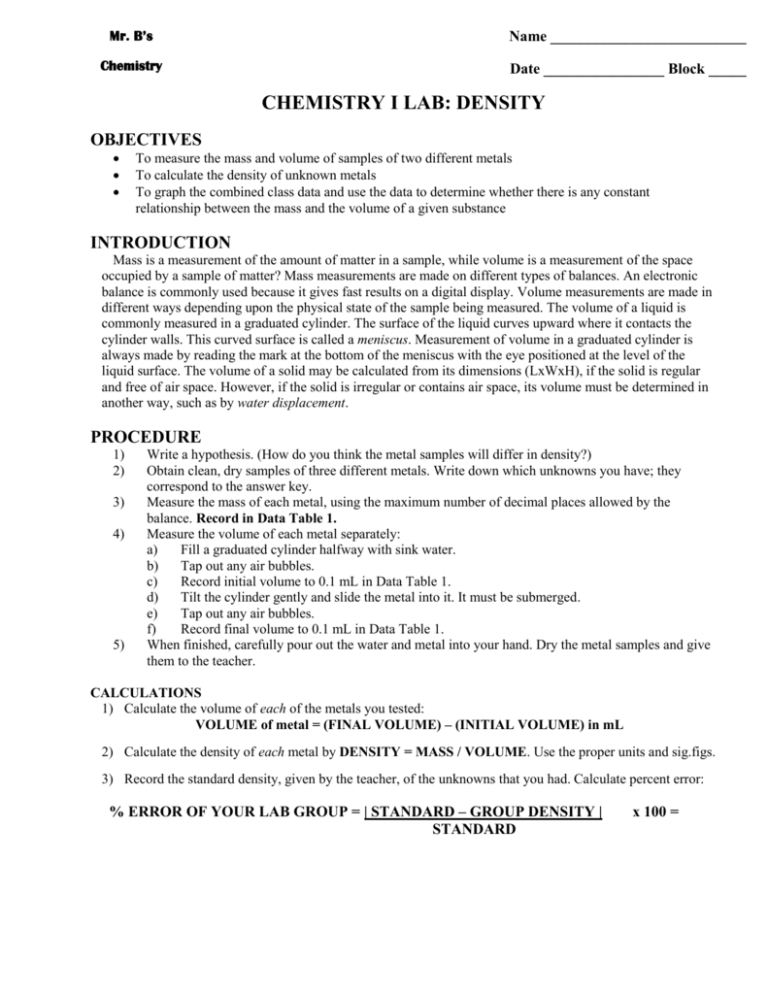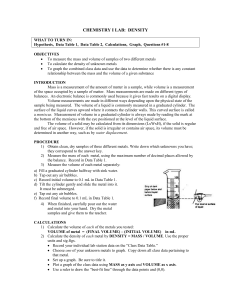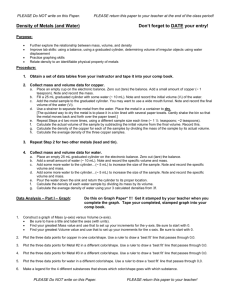chemistry i lab: density objectives
advertisement

Mr. B’s Name __________________________ Chemistry Date ________________ Block _____ CHEMISTRY I LAB: DENSITY OBJECTIVES To measure the mass and volume of samples of two different metals To calculate the density of unknown metals To graph the combined class data and use the data to determine whether there is any constant relationship between the mass and the volume of a given substance INTRODUCTION Mass is a measurement of the amount of matter in a sample, while volume is a measurement of the space occupied by a sample of matter? Mass measurements are made on different types of balances. An electronic balance is commonly used because it gives fast results on a digital display. Volume measurements are made in different ways depending upon the physical state of the sample being measured. The volume of a liquid is commonly measured in a graduated cylinder. The surface of the liquid curves upward where it contacts the cylinder walls. This curved surface is called a meniscus. Measurement of volume in a graduated cylinder is always made by reading the mark at the bottom of the meniscus with the eye positioned at the level of the liquid surface. The volume of a solid may be calculated from its dimensions (LxWxH), if the solid is regular and free of air space. However, if the solid is irregular or contains air space, its volume must be determined in another way, such as by water displacement. PROCEDURE 1) 2) 3) 4) 5) Write a hypothesis. (How do you think the metal samples will differ in density?) Obtain clean, dry samples of three different metals. Write down which unknowns you have; they correspond to the answer key. Measure the mass of each metal, using the maximum number of decimal places allowed by the balance. Record in Data Table 1. Measure the volume of each metal separately: a) Fill a graduated cylinder halfway with sink water. b) Tap out any air bubbles. c) Record initial volume to 0.1 mL in Data Table 1. d) Tilt the cylinder gently and slide the metal into it. It must be submerged. e) Tap out any air bubbles. f) Record final volume to 0.1 mL in Data Table 1. When finished, carefully pour out the water and metal into your hand. Dry the metal samples and give them to the teacher. CALCULATIONS 1) Calculate the volume of each of the metals you tested: VOLUME of metal = (FINAL VOLUME) – (INITIAL VOLUME) in mL 2) Calculate the density of each metal by DENSITY = MASS / VOLUME. Use the proper units and sig.figs. 3) Record the standard density, given by the teacher, of the unknowns that you had. Calculate percent error: % ERROR OF YOUR LAB GROUP = | STANDARD – GROUP DENSITY | STANDARD x 100 = DATA TABLE 1: MASS, VOLUME, DENSITY DATE:____________ METAL ____ METAL _____ METAL _____ METAL ___ mass (g) ___________ ___________ ___________ ___________ initial volume of water (mL) ___________ ___________ ___________ ___________ final volume of water (mL) ___________ ___________ ___________ ___________ volume of metal (mL) ___________ ___________ ___________ ___________ density of metal (g/mL) ___________ ___________ ___________ ___________ standard density values (from teacher): ___________ ___________ ___________ ___________ Lab Group Percent Error ___________ QUESTIONS 1) Why does a pure substance always have the same density? 2) What was the unit of mass used in this lab? 3) What was the unit of volume used in this lab? 4) Describe how water displacement works. 5) What is a meniscus? 6) Can density be used as identification for substances in lab? Why or why not? 7) What may have caused experimental errors? * WHAT TO TURN IN: Hypothesis, Data Table, Calculations, Questions #1-7








